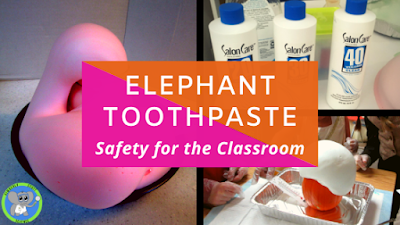Reaction In A Bag Kid Version - Demonstrating Evidence Of A Chemical Change
Reaction in a bag is a wonderful classroom experiment for demonstrating the evidence of a chemical change. We have modified it to make it more kid-friendly for the classroom.
Reaction in a bag is a classic favorite. This lab allows students to break apart what is happening in the reaction. They have to use tables and data, and their evidence to guide them to the next step.
The premise of this lab is to discover what substances cause what parts of the reaction. They first observe the complete reaction with all 4 substances. The reaction produces heat, foaming, gas production, and a color change. Not all of the substances are a part of each stage. This is what makes the activity so interesting.
The premise of this lab is to discover what substances cause what parts of the reaction. They first observe the complete reaction with all 4 substances. The reaction produces heat, foaming, gas production, and a color change. Not all of the substances are a part of each stage. This is what makes the activity so interesting.
The students combine two substances at a time to discover their role in the reaction. It is low-mess because all of it is done in a zip-lock bag.
Performing the reaction in a bag also allows students to observe the gas production and feel the bag getting warm or cold. Some combinations of chemicals will do nothing. Others will be exothermic or endothermic reactions and may produce a color change. This will surely keep students engaged.
Changes to the Experiment.

1. Calcium Chloride
Changes to the Experiment.

1. Calcium Chloride
You do not need to order this from an expensive science supply catalog. Head over to your local superstar and purchase Damp Rid. You want to use the unscented, which is pure calcium chloride. It will save you money and you will have more than you need.
2. Phenyl Red
2. Phenyl Red
This is the biggest change I have made. I did not have phenyl red, nor the budget to order some. I also find it harder to work with. I decided to use red cabbage juice. I boiled it in water until the color faded from the red cabbage. You can also pour boiling water over diced cabbage and let it sit for 30 minutes or more.
Red cabbage reacts differently than phenyl red. Both are indicators, but they cause different color changes. Red cabbage is an acid/base indicator. When reacting with all four ingredients, it turns purple, likely because the substances neutralize each other. In the presence of a base, it will turn more green. In the presence of an acid, it will turn more pink.
When students tested two items together, they quickly noticed that sodium bicarbonate and red cabbage juice turned green. Sodium bicarbonate is a base. This interested them because it did not happen when all four substances were mixed. They were also surprised because the liquid cooled down. When all four are mixed, the students feel the heat from calcium chloride and water reacting. This change will surprise them.
When the students mixed calcium chloride with red cabbage juice, they found it turned a bluish-green color. It didn’t seem to be as strong of a base as baking soda, but it was close. In this reaction, a lot of heat was produced. Students immediately noticed that more heat was generated than when all four substances were combined.
Red cabbage reacts differently than phenyl red. Both are indicators, but they cause different color changes. Red cabbage is an acid/base indicator. When reacting with all four ingredients, it turns purple, likely because the substances neutralize each other. In the presence of a base, it will turn more green. In the presence of an acid, it will turn more pink.
When students tested two items together, they quickly noticed that sodium bicarbonate and red cabbage juice turned green. Sodium bicarbonate is a base. This interested them because it did not happen when all four substances were mixed. They were also surprised because the liquid cooled down. When all four are mixed, the students feel the heat from calcium chloride and water reacting. This change will surprise them.
Each part will do different things and allow students to think like a scientist. If you have a group of 4th-8th graders, I strongly recommend this activity. It is memorable and really applies higher-order thinking skills. I recommend it for the start of a chemical reaction unit, where they will focus on the evidence of a chemical change.
SHOP THIS POST
We have done the planning for you with this complete science and STEM unit.
After the activity, introduce the vocabulary and concepts. This reading passage complements the activity perfectly. Students will be able to relate it to the reaction and the evidence they observed.
LEARN MORE











